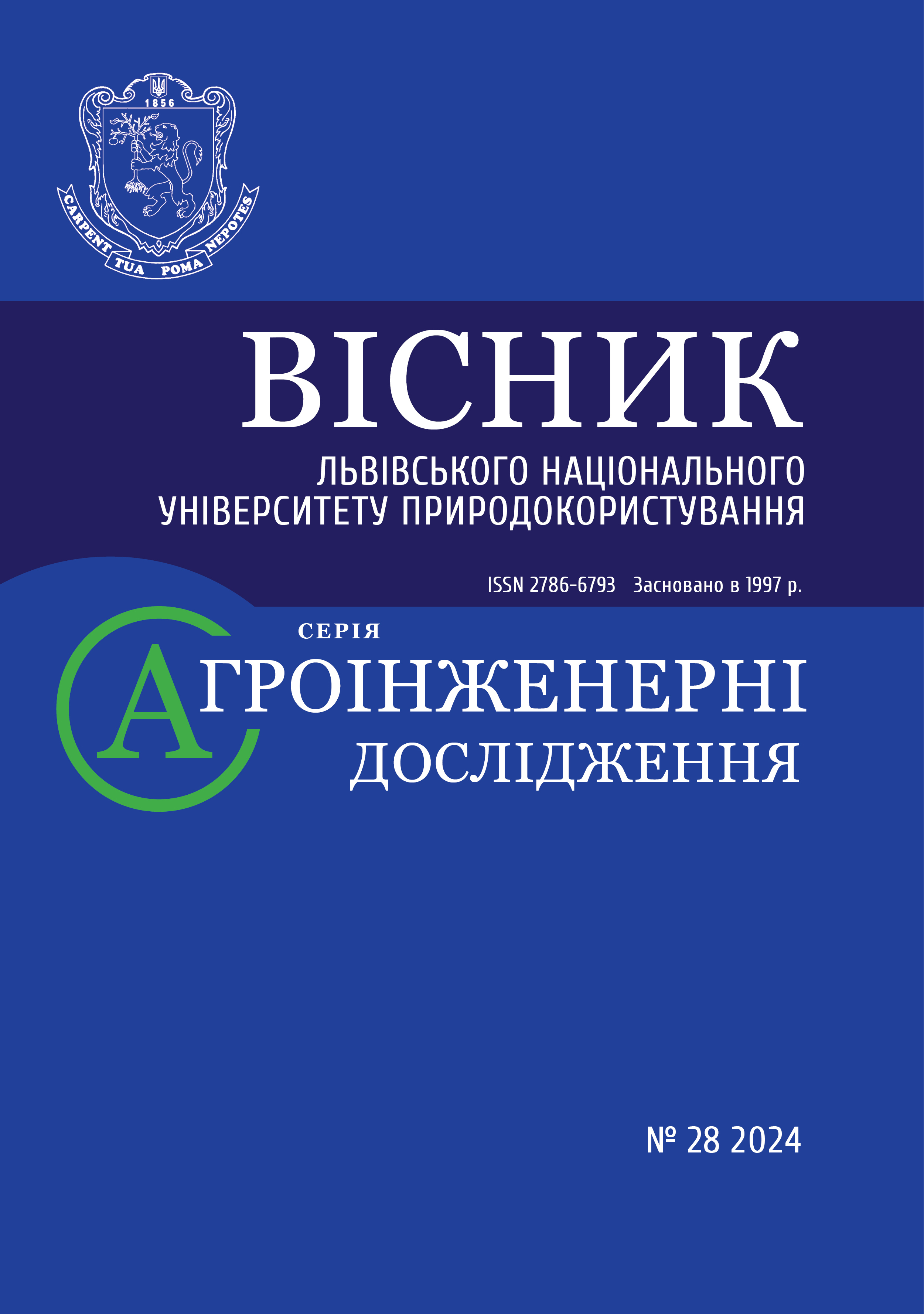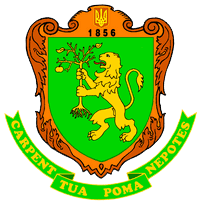Justification of the influence of the roller on the process of compaction of the combined method of field cultivation after harvesting corn
DOI:
https://doi.org/10.31734/agroengineering2024.28.041Keywords:
roller, plant residues of corn, theoretical justification, influence on the process of compaction, soilAbstract
With the proposed combined method of cultivating fields with corn plant residues, several processes are carried out in sequence, namely cutting long and coarse plant residues, distributing them in rows, compacting the materials, crushing the compacted plant-earth mass, and leveling the treated soil surface. Each step is designed to improve the effectiveness of the subsequent processes.
The proposed combined method suggests that after harvesting corn rollers perform a crucial technological function - compacting the cut and rolled stalks along the cultivation lanes. This step ensures a more efficient flow of the subsequent processes in the proposed method.
Theoretical studies were conducted to examine how the roller impacts the compaction of cut and rolled corn plant residues along the cultivation strips. These studies helped establish the roller's main technological parameters based on experimental data regarding field clogging with corn plant residues.
The key technological parameters of the roller include a diameter (Dk) of 0.20 to 0.24 meters and a width (Bk) of 0.20 to 0.25 meters.
A theoretically justified roller has been incorporated into the design of a combined shredder for corn plant residues. Further research is needed to optimize the compaction of stem residues and rollers that are used in combined tillage units for soil cultivation following corn harvest.
References
Bliznjuk, O., Masalitina, N., Mezentseva, I., Novozhylova, T., Korchak, M. (2022). Development of safe technology of obtaining fatty acid monoglycerides using a new catalyst. Eastern-European Journal of Enterprise Technologies, Volume 2, № 6 (116), 13–18. DOI: https://doi.org/10.15587/1729-4061.2022.253655.
Gach, S., Kuczewski, J., Waszkiewicz, C. (1991). Maczyny rolnicze. Elementy teorii i obliczeń. Warzawa: SGGW. 664 p.
Ilchenko, V. Yu., Nahirnyi, Yu. P. ta in. (1996). Mashynovykorystannia v zemlerobstvi. Kyiv: Urozhai, 384.
Kataloh firmy “Dal – Bo” (Preisliste) (1999) na nimetskii movi, Langendorf, Udbye Grafisk. 44.
Kataloh firmy “Franquet” (1997) na anhliiskii movi, Guignicourt. 4.
Kataloh firmy “Kongskilde” (Cennik) (1999), na polskii movi, Kutno. 150.
Kataloh firmy “Kvernelend” (Oferta prodykcyjna) (1998), na polskii movi, Toruń. 62.
Korchak, M. (2022). Characteristics and mechanical and technological properties of the soils of the Podillya and Polissya zone of Ukraine. International Science Journal of Engineering & Agriculture. National Centre for Poland, Poland. Volume 1, № 4, 92–101. DOI: https://doi.org/10.46299/j.isjea.20220104.08.
Korchak, M. (2022). Features of training masters in teaching the discipline "Management of technological processes in plant production". International Science Journal of Education & Linguistics. National Centre for Poland, Poland. Volume 1, № 4. 38-45. DOI: https://doi.org/10.46299/j.isjel.20220104.07.
Korchak, M. (2022). Justification of the constituent factors of production safety. International Science Journal of Management, Economics & Finance. National Centre for Poland, Poland. Volume 1, № 4. 9–16. DOI: https://doi.org/10.46299/j.isjmef.20220104.05.
Korchak, M. (2022). Substantiation of agrotechnical requirements for soil preparation for sowing grain crops. International Science Journal of Engineering & Agriculture. National Centre for Poland, Poland. Volume 1, № 3. 52-61. DOI: https://doi.org/10.46299/j.isjel.20220103.5.
Korchak, M. (2022). Use and quality assessment of test technologies in the educational process. International Science Journal of Education & Linguistics. National Centre for Poland, Poland. Volume 1, № 3. 57–63. DOI: https://doi.org/10.46299/j.isjel.20220103.5.
Korchak, M., Bliznjuk, O., Nekrasov, S., Gavrish, T., Petrova, O., Shevchuk, N., Strikha, L., Kostyrkin, O., Semenov, E., Saveliev, D. (2022). Development of rational technology for sodium glyceroxide obtaining. Eastern-European Journal of Enterprise Technologies, Volume 5, № 6 (119), 16–25. DOI: https://doi.org/10.15587/1729-4061.2022.265087.
Korchak, M., Yermakov, S., Hutsol, T., Burko, L., Tulej, W. (2021). Features of weediness of the field by root residues of corn. Environment. Technology. Resources. Proceedings of the 13th International Scientific and Practical Conference. Rezekne, Latvia, Volume 1, 122–126.DOI: 10.17770/etr2021vol1.6541.
Korchak, M., Yermakov, S., Maisus, V., Oleksiyko, S., Pukas, V., Zavadskaya, I. (2020). Problems of field contamination when growing energy corn as monoculture. E3S Web of Conferences. Krynica, Poland. 6th International Conference – Renewable Energy Sources. Volume 154. https://doi.org/10.1051/e3sconf/202015401009.
Korchak, M. M. (2009). Rozrobka kombinovanoho sposobu ta podribniuvacha dlia gruntu, zasmichenoho roslynnymy zalyshkamy. Visnyk Lvivskoho natsionalnoho ahrarnoho universytetu: Ahroinzhenerni doslidzhennia. Lvivskyi natsionalnyi ahrouniversytet, Vyp. 13, 155–163.
Korchak, M. M. (2022). Obgruntuvannia parametriv dyskovoho robochoho orhanu dlia rozrizannia stebel kukurudzy. Abstracts of ХХXIV International Scientific and Practical Conference “Problems of the development of modern science”, 30 August – 02 September 2022), Madrid, Spain, 319–326. DOI: 10.46299/ISG.2022.1.34.
Korchak, M. M. (2023). Pat. No. 152751 UA. Kombinovanyi podribniuvach roslynnykh zalyshkiv hrubosteblovykh kultur zi shleifovymy robochymy orhanamy. MPK (2006.01), A01B 49/02. No u202203673; declarated: 03.10.2022; published: 05.04.2023, Bul. No 14. URL:https://base.uipv.org/searchINV/search.php?action=viewdetails&IdClaim=284698.
Korchak, M. M. (2023). Pat. No. 154183 UA. Kombinovanyi podribniuvach roslynnykh zalyshkiv hrubosteblovykh kultur z rehuliuvanniam vyrivniuvalnykh robochykh orhaniv. MPK (2006.01), A01B 49/02. No u202301645; declarated: 12.04.2023; published: 18.10.2023, Bul. No 42. URL:https://base.uipv.org/searchINV/search.php?action=viewdetails&IdClaim=286622.
Korchak, M. M., Yermakov, S. V. (2007). Doslidzhennia kharakteru zasmichenosti polia lystostebelnymy ta korenevymy zalyshkamy pislia zbyrannia kukurudzy. Zbirnyk naukovykh prats Podilskoho derzhavnoho ahrarno-tekhnichnoho universytetu. Kamianets-Podilskyi, Vyp. 15, 498–504.
Kuczewski, J., Waszkiewicz, C. (1997). Mechanizacia rolnictwa. Maczyny i urządzenia do produkcji roślinnej i zwierzęcei. Warzawa: SGGW. 552 s.
Lotonenko, I. V., Lytvyniuk, R. S., Syniavin, V. D. (1998). Obrobitok gruntu dlia riznykh gruntovo-klimatychnykh zon Ukrainy: navch. Posibnyk. Kharkiv: Khark. derzh. ahrar. un-t im. V. V. Dokuchaieva. 54.
Medvediev, V. V., Bulyhin, S. Yu., Truskavetskyi, R. S., Laktionova, T. M. ta in. (1996). Suchasnyi stan zemel Ukrainy i zakhody dlia yoho polipshennia. Kyiv: Visnyk ahrarnoi nauky. Vyp. 12, 5–13.
Melnyk, I. I., Bondar, S. M. (2001). Analiz umov vykorystannia gruntoobrobnykh kompleksiv u zoni Polissia Ukrainy. Zbirnyk naukovykh prats Natsionalnoho ahrarnoho universytetu “Mekhanizatsiia s/h. vyrobnytstva”. Kyiv: NAU. Tom 10, 131-138.
Melnyk, I. I., Hrechkosii, V. D., Marchenko, V. V. ta in. (2001). Optymizatsiia kompleksiv mashyn i struktury mashynnoho parku ta planuvannia tekhnichnoho servisu. Navch. posibnyk. Kyiv: Vydavnychyi tsentr NAU, 48.
Nahornyi, N. N. (1994). Tekhnologii i tehnicheskie sredstva pochvozaschitnogo konturno-meliorativnogo zemledeliya. Kiev: Urojay, 248.
Sheichenko, V., Marynchenko, I., Dudnikov, I., Korchak, M. (2019). Development of technology for the hemp stalks preparation. Independent Journal of Management and Production.State agrarian and engineering university in Podilia. Vyp. 10, 7, 687–701.
Shevchenko, I. A. (2002). Obgruntuvannia tekhnolohii ta tekhnichnykh zasobiv dlia obrobitku gruntiv na bazi yikh ahrofizychnykh pokaznykiv: avtoref. dys. ... dokt. tekhn. nauk. Kyiv. 36.
Voitiuk, D. H., Baranovskyi, V. M., Bulhakov, V. M. ta in. (2005). Silskohospodarski mashyny. Osnovy teorii ta rozrakhunku. Za red. Voitiuka D. H. Kyiv: Vyshcha osvita, 464.
Voitiuk, D. H., Dubrovin, V. O., Ishchenko, T. D. ta in. (2004). Silskohospodarski ta melioratyvni mashyny. Za red. Voitiuka D. H. Kyiv: Vyshcha osvita, 544.
Wożnijk, W (2002). Ciągniki i maszyny rolnicze. Budowa, przeznaczenie. Poznań: PIMR. 905 p.
Zaiats, O. M. (1999). Sivozminy: teoretychni osnovy, proektuvannia ta osvoiennia. Kharkiv, 90.
Zaluzhnyi, V. I., Hrytsyshyn, M. I. (1997). Osoblyvosti komponuvannia i vykorystannia gruntoobrobnykh kombinovanykh ahrehativ z pasyvnymy robochymy orhanamy. Mashynovyprobuvannia na sluzhbi prohresu mashynobuduvannia i silskohospodarskoho vyrobnytstva: zb. nauk. prats. Doslidnytske: UkrNDIPVT. 87–92.


